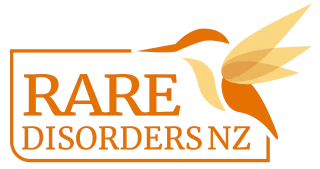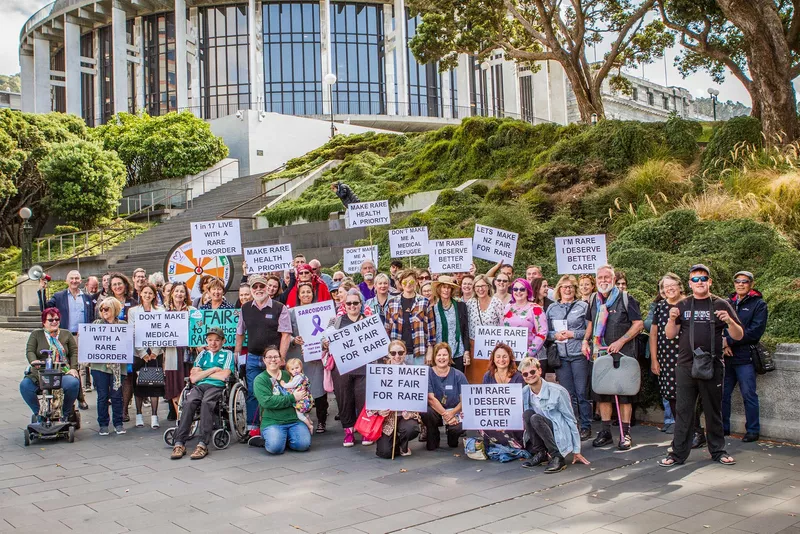NZ Herald - 'Sliding around in the dark': What it's like to have a rare disorder in New Zealand
28 Feb 2021
Medical advice from Facebook, waiting years for a diagnosis, juggling dozens of specialists and even wishing it was cancer instead: these are the realities faced by the thousands of New Zealanders living with a rare disorder.
Some might be the only person in the country with their illness, but in total they amount to 300,000 Kiwis. It's comparable to the number with diabetes, but their pathway to care is much less certain.
For conditions that don't tick a box on a medical form – and perhaps have to be explained to the professionals themselves - there's not an easy pathway to care, treatment or support.
On International Rare Diseases day, marked today, Kiwis with rare disorders are campaigning to be recognised with a national framework.
Lizzie Haldane, 17, was diagnosed with a rare disorder by "the most amazing luck". Born with a catastrophic heart defect she had only a few days to live when her symptoms rang a bell for a recently returned cardiologist who had happened to be there that day.
She was stabilised, given open heart surgery at five days old, and diagnosed with the very rare condition known as 22q11.2 deletion syndrome - often simply 22q.
"He came back to Rotorua where Lizzie was born and he was on duty that weekend. If he hadn't been, Lizzie would have died," her mum, Sue, said.
"It was day three, but she probably would have died in a couple more days."
The Haldanes' story is not common: rare disorders sufferers typically wait five to seven years for a diagnosis, and endure three misdiagnoses in that time.
And as a condition affecting so few people around the world, a diagnosis of 22q deletion syndrome in 2003 means very little.
The syndrome - affecting one in 2000 to 4000 births - has 180 abnormalities, affecting everything from the heart to speech, to mental health.
At times Lizzie has 12 different specialists - "a lot of balls in the air at any one time," Sue said.
"You become this all-singing, all-dancing, quasi-medical, educational expert for your child, stitching together a treatment plan across a myriad of specialties."
Lizzie's challenges could be separated into "hardware" and "software". Mental health difficulties – "software" - were 10 times more likely in people with 22q, but Haldane had struggled to get her daughter the support she needed.
"When Lizzie was around seven years old … her views were catastrophic: would the world end today? Would Mt Ruapehū explode? Would she die in the night?
"Soon she was unable to go outside."
But her observations were "often been challenged or ridiculed by clinicians," she said.
Lizzie said anxiety was the biggest barrier, but it was an added challenge to explain her condition every day.
"Everyone knows about diabetes or asthma, but they don't really know about 22q," she said.
"It comes with a lot of stress and anxiety. Some things that normal people can handle, I can't."
"It's quite tough making friends. I am very lonely at the moment."
Another mother of a child with 22q said she has struggled to access mental health care for her 17-year-old son when he had a breakdown two years ago.
She has asked not to be named because of the stress of the condition on her son's wellbeing.
As he got older, his mental health deteriorated until he became so distressed at the thought of school that his mum would received 20 texts a day asking to be picked up. One morning he was "rolled into a ball" on the doorstep of the house sobbing "don't send me to school".
Although 22q had a high risk of schizophrenia, the rareness of the condition made it impossible for them to find mental health support.
"On paper his syndrome says massive mental health problems, high chances of schizophrenia," she said.
"When you've got a parent and a GP saying he needs help, on paper he should have just got help straight away."
"We shouldn't have to jump through hoops."
"It should be automatic, like saying 'you've been diagnosed with cancer, yes you're going to get cancer help'."
As well as a pathway to treatment, a framework could provide an informational hub. At the moment, parents of 22q children share advice over Facebook.
"Facebook is not good enough. It's great to have that support from parents, but we need somewhere more solid to go to for information."
"If you're already been to your GP, you've got nowhere else to go."
In the early pre-internet days of her son's diagnosis, when he was constantly sick, they "just winged it one day at a time".
East Auckland man Aubrey Christmas was diagnosed with amyloidosis in 2013, a terminal condition without a cure.
Amyloidosis caused proteins to transform into fibres and spread around the body, often triggering organ and tissue malfunction. Aubrey had a life-saving liver transplant in 2016.
Aubrey, 57, had already outlived his life expectancy, with most affected family members dying in their early 50s.
Aubrey's wife Jaime said his condition caused progressive loss of sensory and motor skills, heart problems, compromised renal and gastrointestinal function.
"He never knows what will hit him first when he wakes up."
But some of the biggest challenges were around its rarity: the lack of adequate support, awareness and access to medications.
Though data was lacking in New Zealand, they were believed to be one of five families in the country with Aubrey's specific condition – hereditary TTR amyloidosis.
Sometimes his low blood pressured caused him to be light-headed, needing to lean against the wall for support.
"People noticing me are quick to assume I am drunk and do not offer help," he said.
As Aubrey's full-time carer and the chief executive of NZ Amyloidosis Patients Association, Jaime was unable to work and felt torn between him and their four children - "constantly living on the edge and expecting the worst to happen".
After long struggling to access the medications in New Zealand that would prolong his life, a European pharmaceutical company had reached out and offered Aubrey treatment.
"Had we not advocated on our own, he would not have come this far," Jaime said.
"New Zealand is not a third-world country, but in some aspect, mimics one."
Aubrey and Jaime, as well as the 22q mothers, were signatories of a petition to be taken to Health select committee Chair Liz Crigg next month, calling urgently for a national framework.
Rare Disorders NZ Chief executive Lisa Foster said an official strategy would give patients a mechanism for treatment and support, as well as providing research and data around their conditions
The current New Zealand health system was "set up to fail" them, she said.
Australia launched the National Strategic Action Plan for Rare Diseases in 2020, and Taiwan recently celebrated the 20-year anniversary of their framework. The UK even had a minister for Rare Disease policy.
"New Zealanders would be shocked to learn how far behind we've fallen," Foster said.
"People are falling, sliding around in the dark, barriers at every turn."
"We protect rare animals, we protect rare buildings. Why can't we protect rare people?"
Some mothers of children with rare disorders had told her they wished their children had cancer instead.
"She was on a ward and all the other children were getting cancer packs with the beads and things and her child didn't," she said.
"The people in the ward said they felt sorry for her, because they got automatic support."
"They had a coordinator, so they have a pathway – a bit like a train on a track. The train goes along the track, they don't have to build the track as they go."
"There's a cancer action plan, there's a cancer agency, there's a cancer strategy … we just want the same."
Rare Disorders NZ had been fighting since 2018, and in that time their funding had been reduced from 120,000 to 60,000 a year. There was no guarantee of funding after 2023.
The organisation was meeting with Health Minister Andrew Little on Monday in the hopes of co-designing a national framework.
The Health minister said the meeting was an opportunity to hear directly from Rare Disorders NZ on what their aspirations and expectations were.
"I understand people living with rare disorders can face challenges in accessing medicines, supports and services," he said.
"While the ministry does not currently have a specific rare diseases policy or framework, there is a range of work underway to improve the health and disability system."
"These pieces of work aim to improve the health and wellbeing of all New Zealanders, including people who are living with, or supporting family members with, rare disorders."
A Ministry of Health spokesperson said the ministry met regularly with Rare Disorders NZ, and was committed to conversations around improving support.
But Rare Disorders NZ Board Chair James McGoram said quarterly meetings with the ministry must have so far "fallen on deaf ears".
"There is an over-arching lack of consultation and recognition for rare disorders," he said.
Existing structures were "out of date, out of step" with international developments and the government's commitments, he said.
The pandemic had hit pause on the fight for a national framework, but also highlighted the need for one. People with rare disorders could be immuno-compromised, but not officially recognised as such.
Sue Haldane said the onset of coronavirus had been "really really scary times".
"It was very distressing that there was no plan, because we have no cohesive plan anyway for people with rare disorders," she said.
"When something like Covid happens and you've got a pandemic and by definition, this population of highly vulnerable people, there is no plan for that."
"This is Covid but there will be others... in times of disasters of any kind there is no provision for vulnerable populations like ours."
None

